Edge of the Cedars State Park Museum in Blanding is a must-see RV travel destination. Everyone visiting the Four Corners area in the American Southwest needs to start here. Travel into the land of the Ancestral Puebloan. You’ll get a baseline of cultural knowledge that will help build a clearer picture of the wonders of Bears Ears National Monument or Hovenweep or Mesa Verde.
Disclosure: This post contains affiliate links. If you buy something from one of our affiliates, we receive a small commission at no extra charge to you. Thanks for helping to keep our blog up and running!
Table of Contents
Visiting Edge of the Cedars State Park Museum
Our first visit to Southern Utah was over 30 years ago – and we’ve been more than 30 times since. We love the area’s incredible scenery and prehistory – from ruins to rock art.
It seems we can’t get enough hiking and biking, RV camping and backpacking, exploring, and adventuring in the heart of the Four Corners. But if you’ve never been, you need to start by visiting Edge of the Cedars State Park Museum in Blanding, Utah.
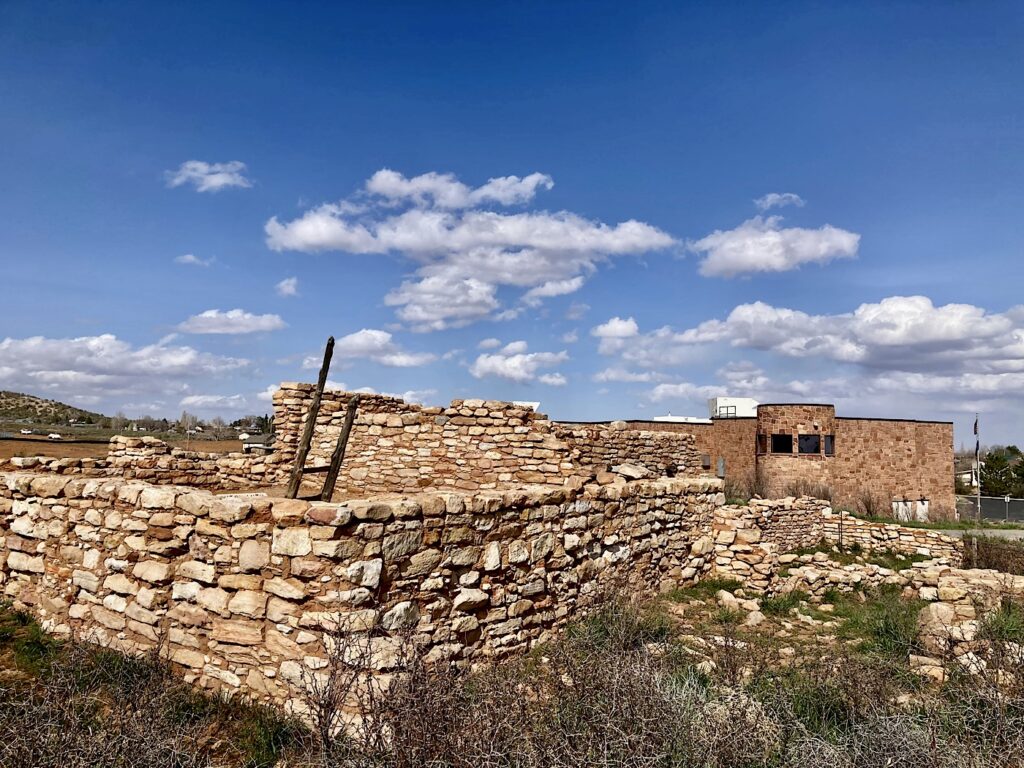
Why check out a small museum in Blanding, Utah?
This Utah state park museum in Blanding is an incredible introduction to world of the Ancestral Puebloan people (formerly known as the Anasazi). They are the architects who built the jaw-dropping cliff dwellings and stone towers in Mesa Verde, Hovenweep, and throughout the Four Corners including Bears Ears National Monument on Cedar Mesa.
The museum is located at the site of a prehistoric agricultural village occupied between 750 A.D. and 1220 A.D. It was home to various groups of people – from the Ancestral Puebloans to the Navajo and Utes. Climb down a wooden ladder into the dark mystery of a kiva. It’s just one of the amazing experiences at Edge of the Cedars.
What’s a kiva?
If you’re not overly familiar with the American Southwest, you may not have heard the term “kiva” before. A kiva is a ceremonial building. Sometimes built partially underground, access is by a hole in the roof and ladder. Kivas were used by the Ancestral Puebloans. Kivas are still in use by Puebloan people today.
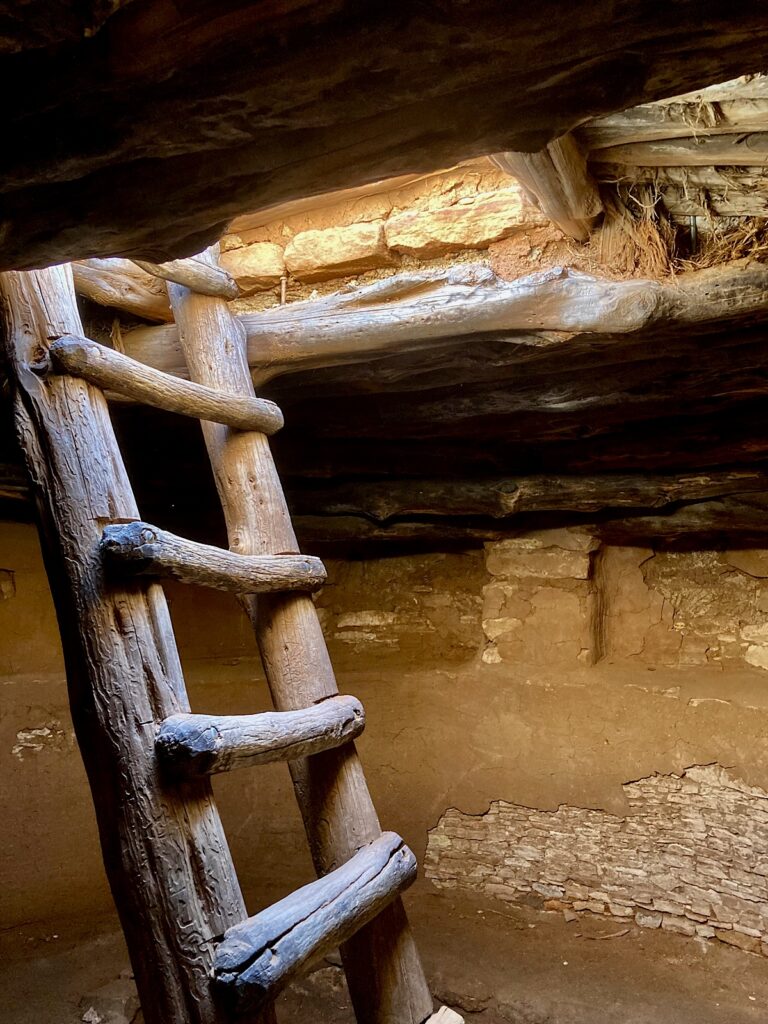
And another question – are there cedars in Utah?
Nope. Early settlers to the area saw the ubiquitous Utah juniper trees and called them cedars. The name stuck. Edge of the Cedars refers to the fact that this location is at the intersection of two bio-zones. It’s an area where the piñon-juniper uplands and the sage grasslands overlap. It was this mixing of forest and grasslands – doubly rich in resources – that was so appealing to the Ancestral Puebloans.
Edge of the Cedars Museum
Built in 1978, the red stone building compliments the prehistoric architecture. An Archaeological Repository Wing for research and storage of collections from southeast Utah added to the facility’s size and purpose in 1996. As you approach, take a moment to check out the sculptures in the garden.
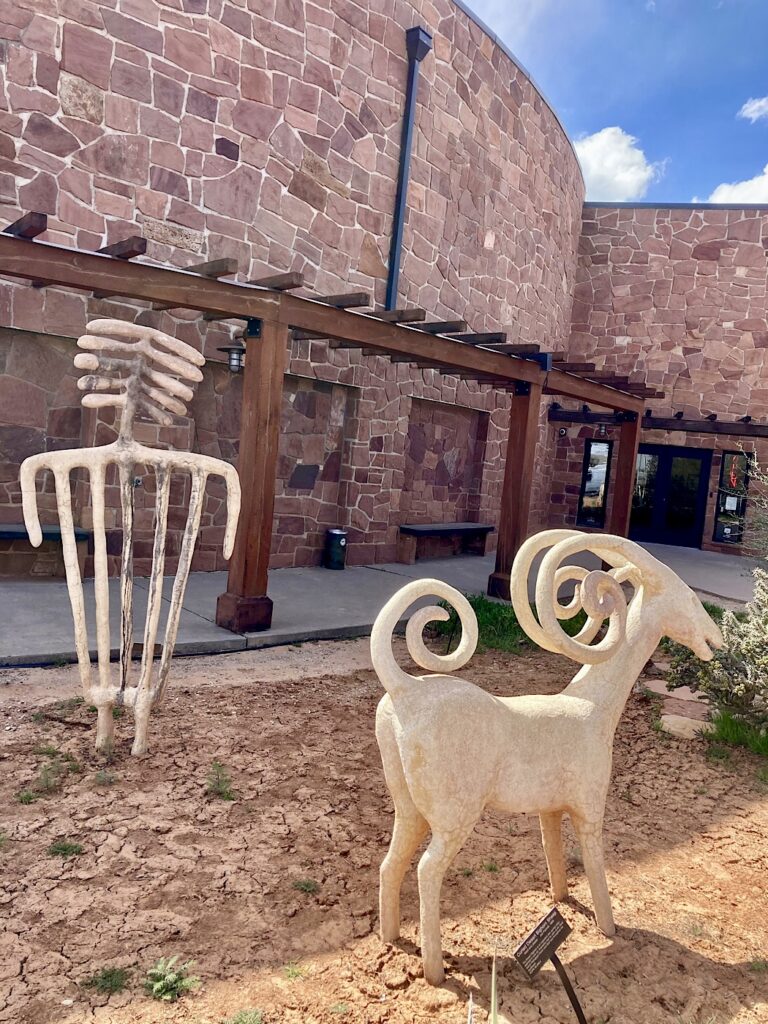
Created by Bluff artist Joe Pachak, these sculptures depict actual rock art images in 3-D form. Rock art is only one of the cultural treasures in the Four Corners area. There are two types of rock art in the area: petroglyphs and pictographs. Petroglyphs are chipped or carved images. Pictographs are painted images.
Pachak’s work continues inside the museum. Here he painted walls with images from actual rock art sites. It represents different art styles, periods, cultures, and themes. Apparently, an interpretive booklet about the murals is available at the reception desk. I was in too big of a rush to dive into the museum displays to get a copy.
Next time!
Main Floor of the Museum
Glass cases with massive pottery jars immediately catch the eye – part of a display called Discovery! In 2005 Edges of the Cedars State Park Museum and Bureau of Land Management’s (BLM) Monticello Field Office collaborated to create a special exhibit. It focuses on tracing the stories of people who did the right thing and by doing so became models of the ideal of cultural stewardship.
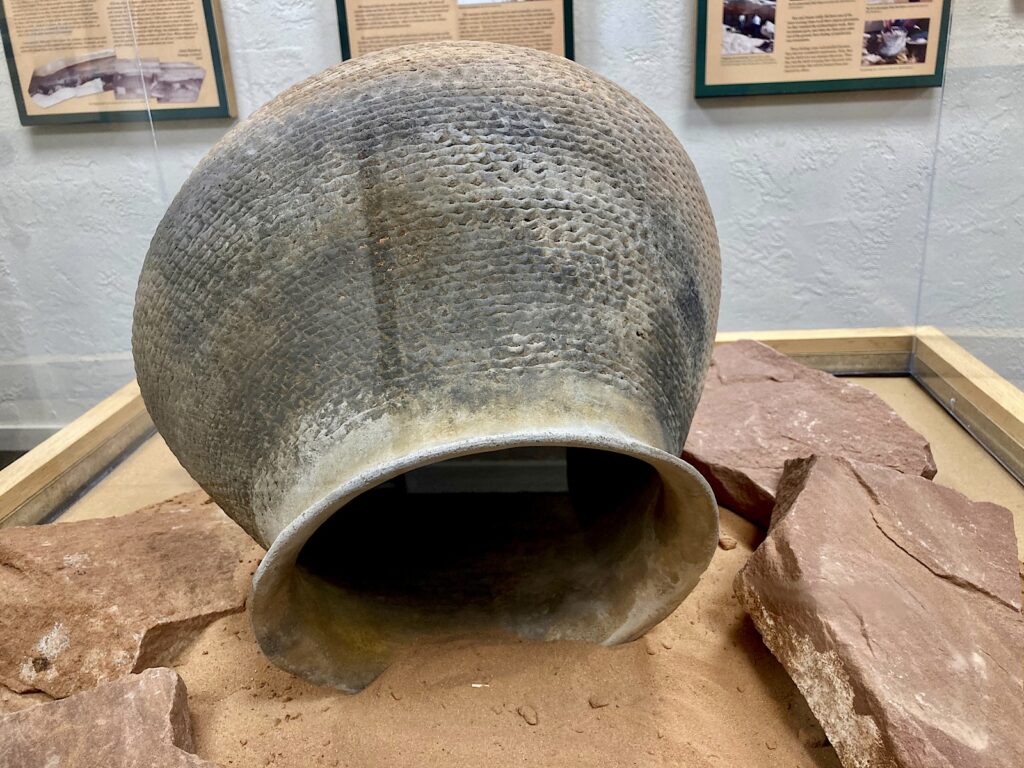
Since 1906, the American Antiquities Act makes the unauthorized removal of artifacts from public land a felony. The 1979 Archaeological Resources Protection Act specifically makes the removal of artifacts or damage to archaeological sites on public lands punishable by fines or imprisonment.
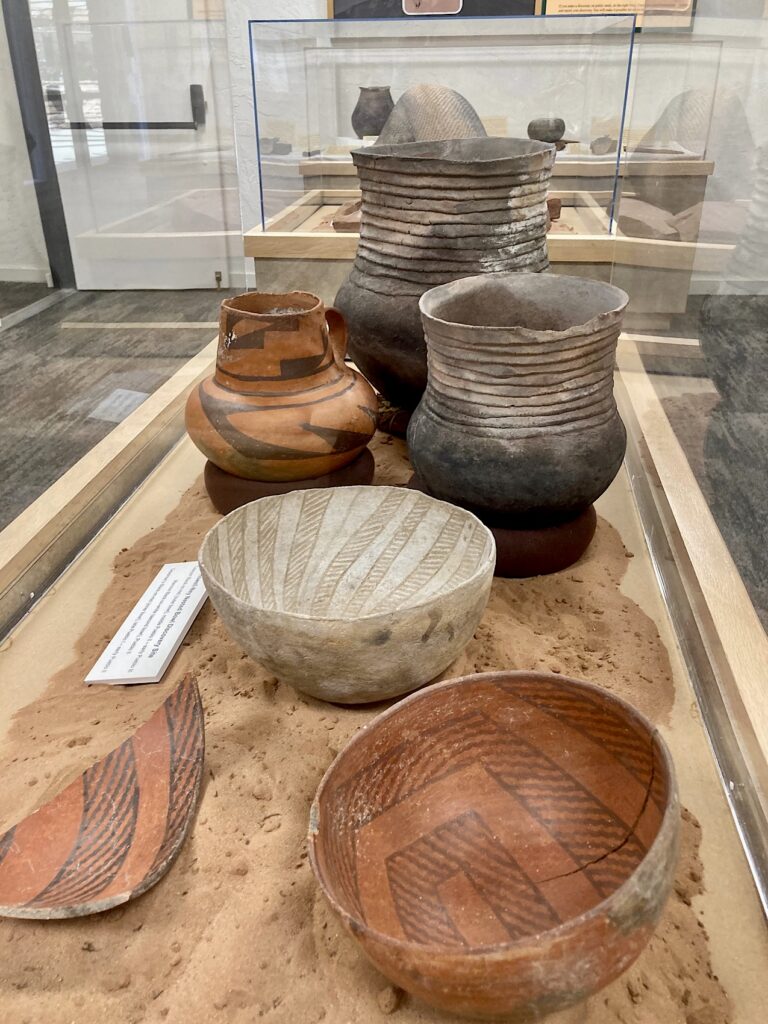
Discovery!
The people featured in the Discovery exhibit all found amazing cultural remains. These included pots and points and even a cache of digging sticks. Rather than taking the artifacts, they told either museum or BLM staff about their discoveries. Returning later with an archaeologist, some assisted with excavation, documentation and recovery of the pieces. Their finds are now studied by specialists and enjoyed by visitors.
Pothunters
Yes, it’s an issue even to this day. Blanding made headline news in 2009 when federal agents arrested 17 people – the result of a controversial two-year undercover sting aimed at a black market in ancient American Indian artifacts.
Upstairs Exhibits
After watching the introductory video – truthfully, I spent a bit of time admiring the wall art – climb upstairs to displays discussing everything from time periods to styles of kivas, masonry and painted ceramics, points, and tools to sandals and weaving. They even have a dog hair rope made from braided cords of white dog hair!
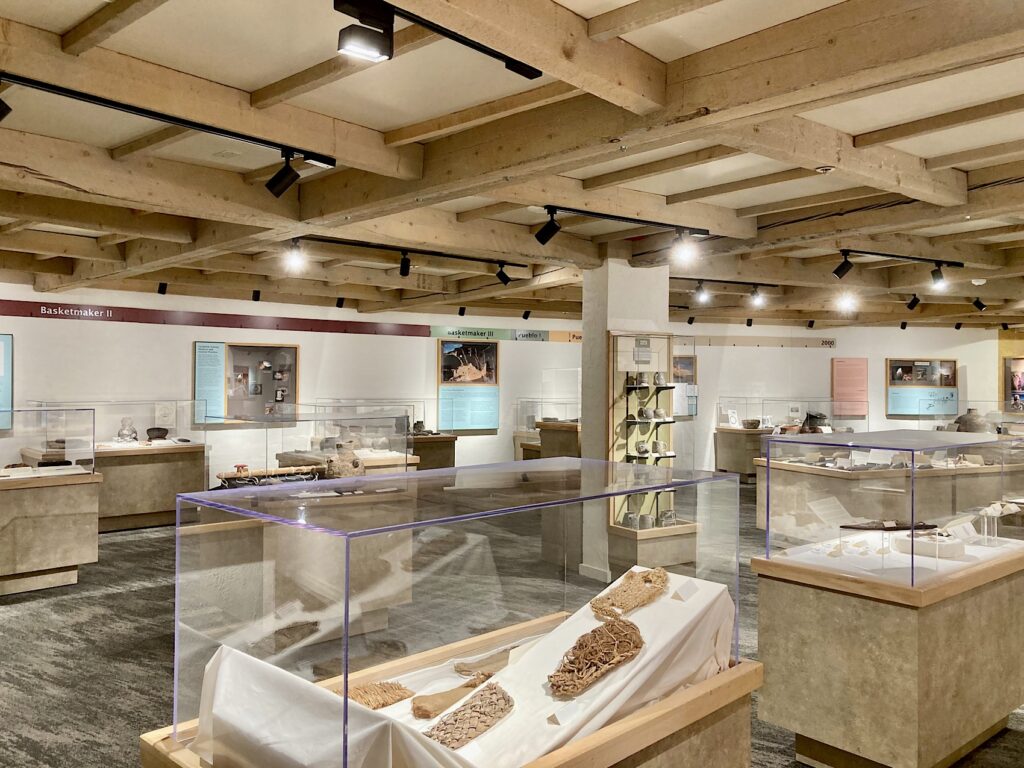
And this is just one room.
Walk up one ramp and learn about the Earthwatch/BLM Rock Art Project. Dating from approximately 3000 BC to AD 1300, this rock includes pictographs and petroglyphs left by Archaic hunter-gatherers, Ancestral Puebloans (Anasazi) and Freemont peoples.
The records – 3,000 original drawings, 11,000 color slides, and 5,000 prints, negatives, and transparencies – make up the largest and best-documented collection of prehistoric and ethnographic rock art images for southeast Utah.
Take a walk up another ramp for a panoramic overview of the Edge of the Cedars Great House site (outdoor portion of the museum). The window exhibit interprets the site as it might have looked around AS 1075, after the great house, great kiva, and road were constructed. On a clear day you can see the Bears Ears poking up on the horizon.
As you move on, take a moment to steady yourself because the next room will take your breath away.
Visible Storage at Edge of the Cedars State Park Museum
Feast your eyes beyond the glass walls to the rows and rows and rows of pottery. This museum is home to the largest collection of displayed Ancestral Puebloan (Anasazi) pottery in the Four Corners area.
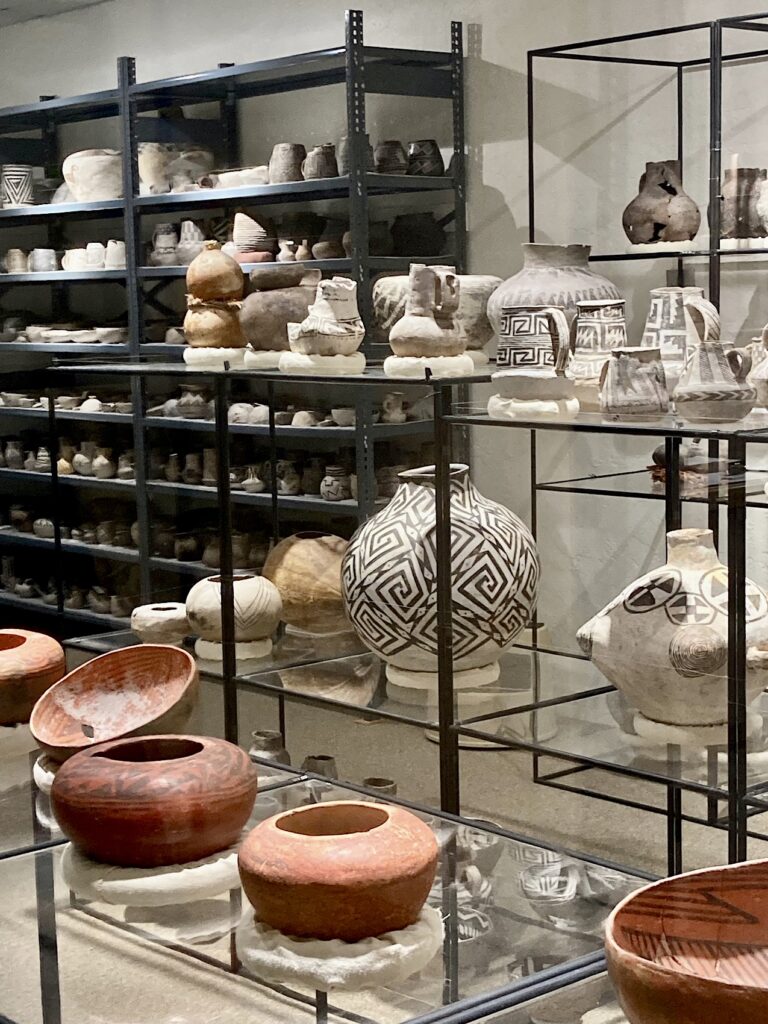
The Visible Storage room is a combination of exhibit and lab. If you’re lucky, you may get to watch the curator at work. Regardless, you will get to look at over 400 pots – with a wide range of sizes, shapes and decorative patterns – dating from the late Basketmaker III period to the Pueblo III period.
More than Pottery
There are a few additional items that will you speechless when you learn their tales. Leaning up against the back wall is a wooden ladder. But it’s not just any ladder.
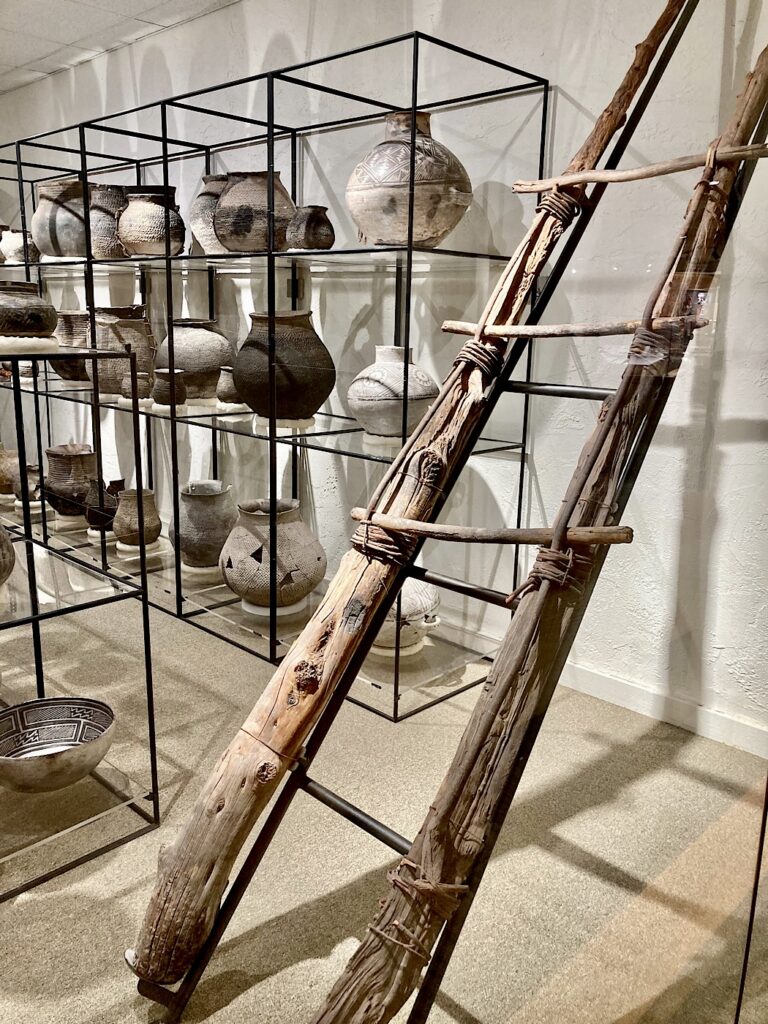
If you look on the opposite wall behind you, you’ll see a photo taken from inside Perfect Kiva. Perfect Kiva is located in one of the Grand Gulch canyons on Cedar Mesa. The kiva ladder in the visible storage is the same ladder you see in the photo. BLM took the ladder from Perfect Kiva before it was destroyed, replacing it with a replica. Now look at the ladder in front of you again.
Impressed? Gob-smacked might be more like it!
Another brilliant artifact on display is the bright red Macaw feather sash (or apron) in the front corner of the room. Scarlet Macaws are parrots native to Mexico. Strands of yucca cordage are wrapped with over 1000 feathers. On top of the sash is an Abert’s squirrel pelt – native to mountainous regions in the area.
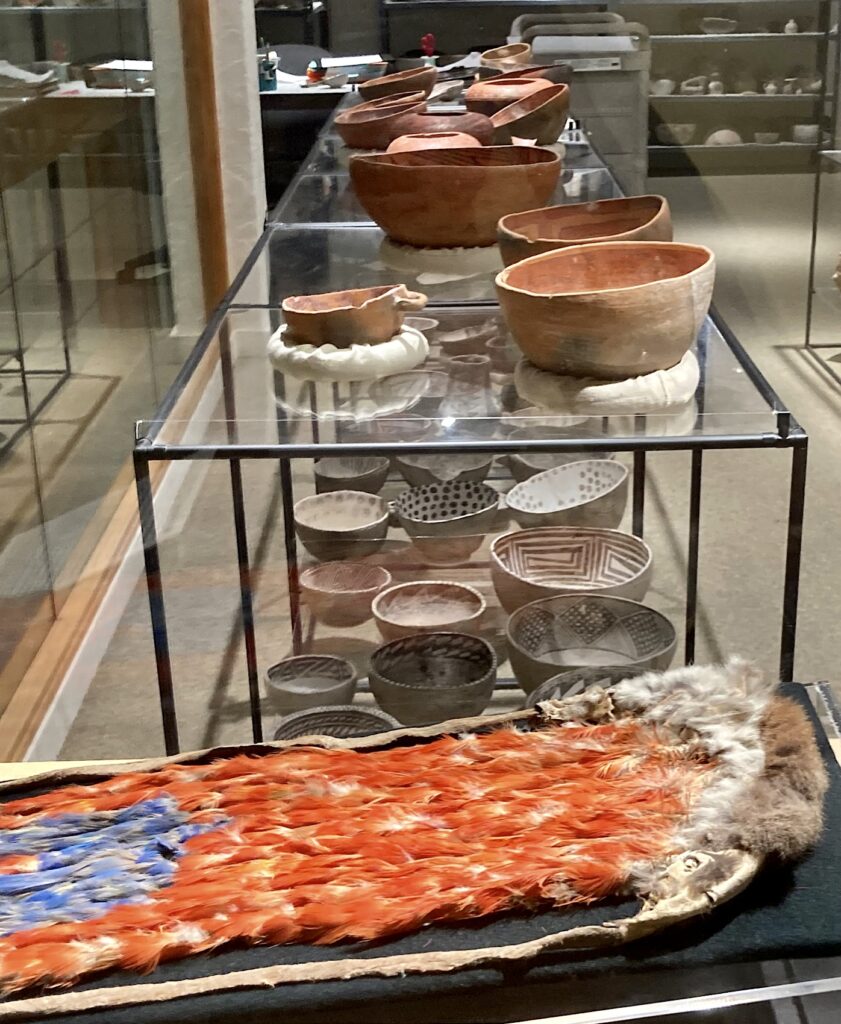
The sash dates to A.D. 1050-1150. It’s the only one known of its kind. How cool is that?
Village Life at Edge of the Cedars
Once you can tear yourself away from gawking at the treasures behind glass, head into the last exhibit room. Interpretive signage discusses Edge of the Cedars and the two villages – one dating to the late Pueblo I period (late A.D. 800s) and the other to the Pueblo II period (A.D. 1050-1150).
The first village showed evidence of fire hearths and artifacts. Pottery bowls and jars, grinding metates, and stone and bone tools were found. This suggests everyday living.
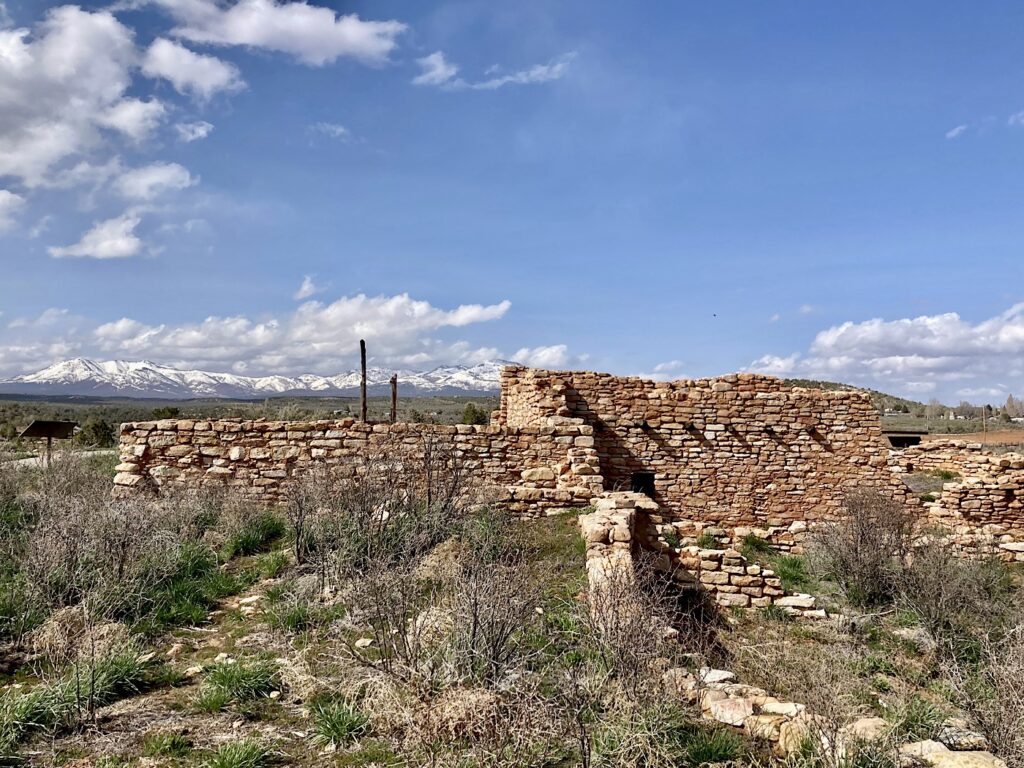
The second village Great House rooms didn’t show signs of domesticity. It suggests that the Great House was for built for ceremonial and/or storage purposes. By the early A.D. 1200s – almost 1,000 years ago – the community at Edge of the Cedars began to fade away.
Today as you step outside and walk, you’ll notice piles of stones in unexcavated portions of the village. The Great Kiva – over 40 feet (13 m) in diameter – has not been excavated. But that doesn’t mean you can’t get a sense of the mystery as you climb down the ladder into a smaller kiva near the Great House.
What are you waiting for? Visiting Edges of the Cedars State Park in Blanding and get an understanding of the area’s prehistory before you head out southwest to Bears Ears and Cedar Mesa or southeast to Hovenweep or south towards Bluff.
When You Go to Edge of the Cedars
Blanding is about 310 miles ( km) southeast of Salt Lake City or 75 miles ( km) south of Moab, Utah. From US 191 in Blanding, follow signs to Edge of the Cedars State Park Museum on the edge of town (660 West 400 North).
The museum is open March to November, 7 days a week from 9 am to 5 pm. Entrance fees are $5/adult ($3/Utah senior 62 & over).
Heading out to Cedar Mesa? Check out Moon House if you’re into active travel adventure!
There are several RV Parks in Blanding. We’ve stayed at Blanding RV Park (861 S Main St). It’s a 1.9-mile walk ( km) or 5-minute drive to the museum and works fine. If you don’t mind a little longer drive, we like making an adventure base out of Sand Island Recreation Area located 3 miles ( km) west of Bluff (but note that this is also a busy campground for San Juan River float trips and it fills up early.
If you’re heading to the southwestern part of the state, be sure to check out our post “Outdoor Adventures while camping in Snow Canyon State Park, Utah.”
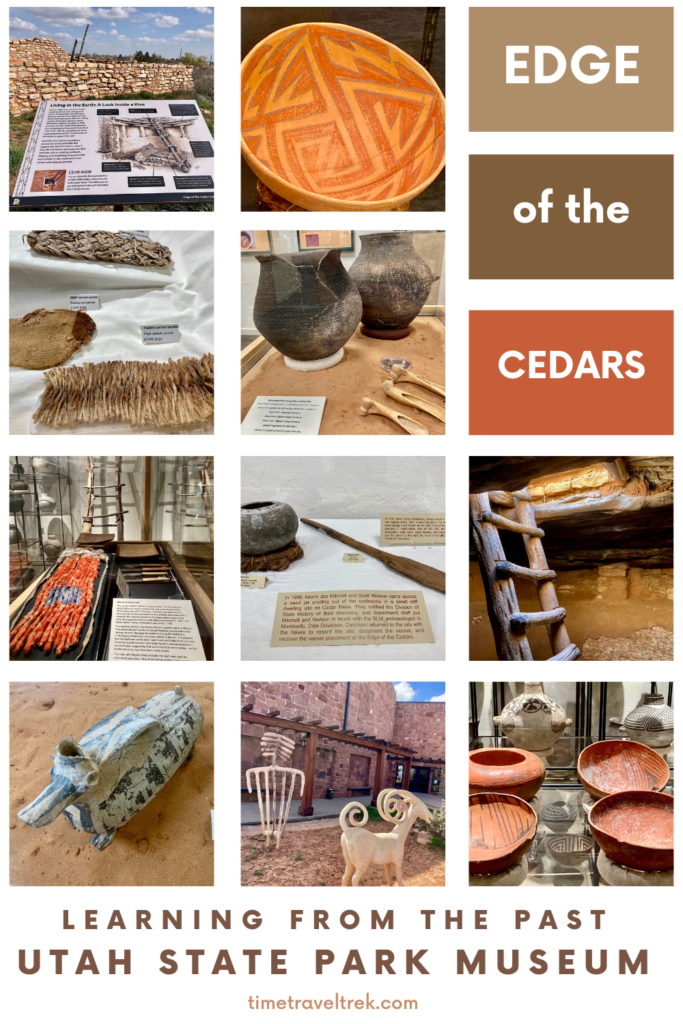



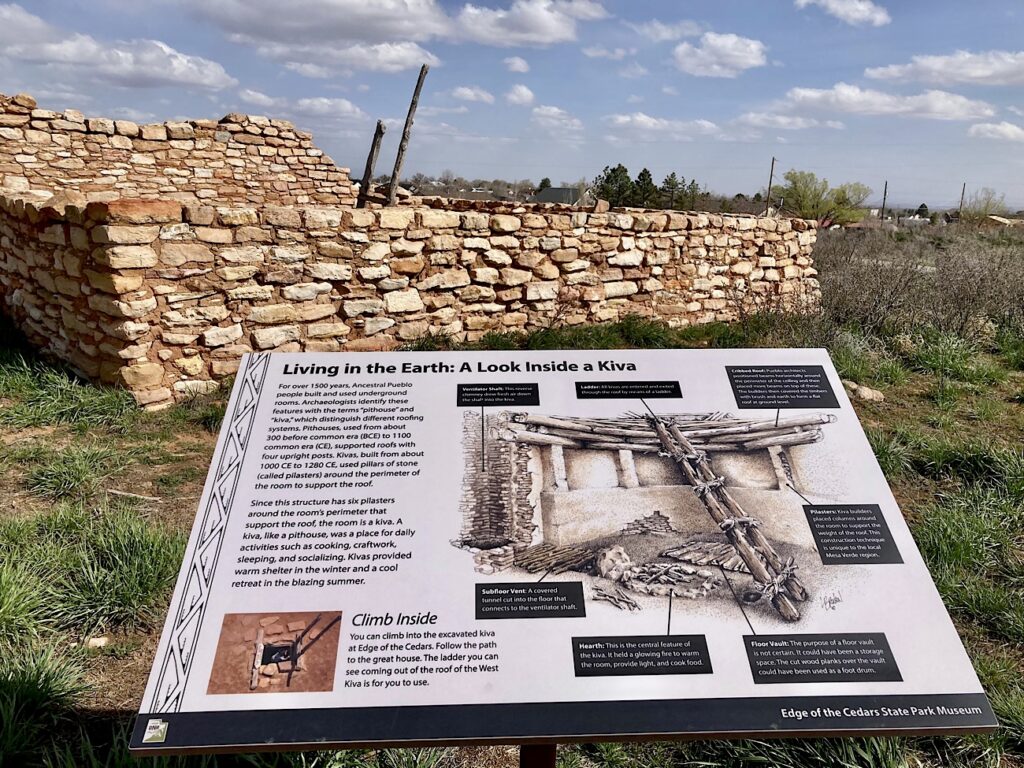
This is interesting. And thank you for the wealth of information you’ve provided about this part of the US as I’m not really familiar with it.
The Four Corners area in the American Southwest – and this little museum in Blanding – are well worth getting to know!
This definitely makes me want to get out and explore the Southwest more!
It’s a fascinating part of the country!
Thanks for this great review of the Edge of Cedars State Park Museum. No, I didn’t know what a kiva was and I have never seen anything like this before. Should be on the list of MUST-SEES!
Agreed!
I’ve lived in Utah and still hadn’t heard of Edge of Cedars State Park before. Utah is pretty amazing, with many beautiful national parks that probably get more attention than the state parks. I have been interested in the Four Corners area so I’ll add this state park to my list, for sure. I would love to see the colorful pottery and learn more about the indigenous people who lived here.
It’s the same everywhere – the more you see, the more you need to see!
This looks like a fascinating place! The photos are stunning and really capture the mystery of this heritage. I especially liked the kiva, and can imagine what an intense feeling might have been to descend down to the center of some mystic ceremony. I hope to see it for myself someday!
I hope you do get a chance to visit, Ivan!
Oh, I love museums and would love to visit this museum. We’ve been in this area, but haven’t visited this museun back then. We went to Mesa Verder NP and some other sites.
Worth heading back that way on another trip!